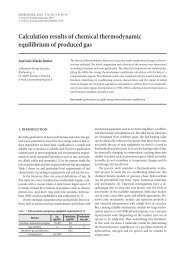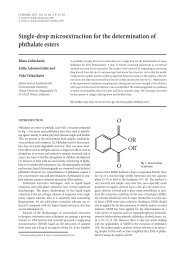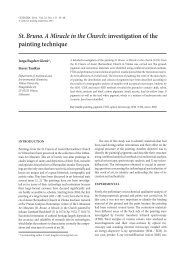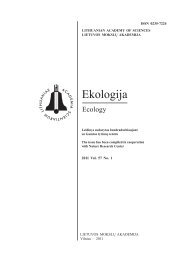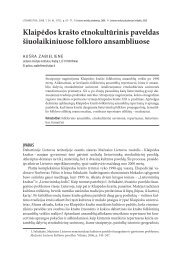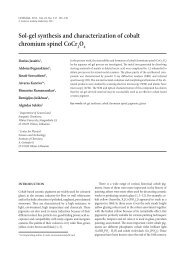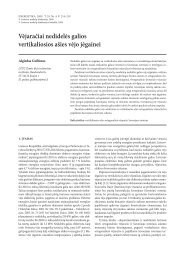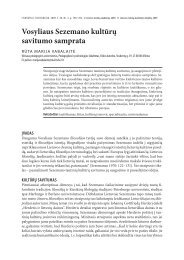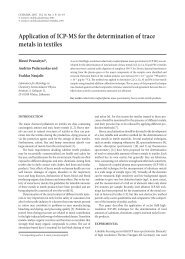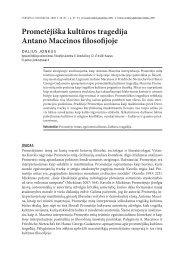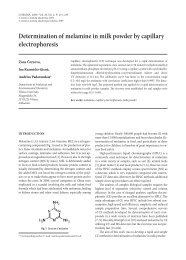Biological nitrogen fixation in acid soils of Lithuania - Lietuvos ...
Biological nitrogen fixation in acid soils of Lithuania - Lietuvos ...
Biological nitrogen fixation in acid soils of Lithuania - Lietuvos ...
Create successful ePaper yourself
Turn your PDF publications into a flip-book with our unique Google optimized e-Paper software.
žemės ūkio mokslai. 2008. t. 15. Nr. 3. P. 67–72<br />
© lietuvos mokslų akademija, 2008<br />
© lietuvos mokslų akademijos leidykla, 2008<br />
<strong>Biological</strong> <strong>nitrogen</strong> <strong>fixation</strong> <strong>in</strong> <strong>acid</strong> <strong>soils</strong> <strong>of</strong> <strong>Lithuania</strong><br />
Edmundas Lap<strong>in</strong>skas<br />
Vėžaičiai Branch <strong>of</strong> <strong>Lithuania</strong>n Institute<br />
<strong>of</strong> Agriculture, Gargždų 29,<br />
LT-96216 Vėžaičiai, Klaipėda distr.<br />
E-mail: edmundas@vezaiciai.lzi.lt<br />
The results <strong>of</strong> this study <strong>in</strong>dicate that Rhizobium legum<strong>in</strong>osarum bv. trifolii is widely distributed<br />
<strong>in</strong> slightly <strong>acid</strong> <strong>soils</strong> with pH KCl<br />
5.6–6.0. The average content <strong>of</strong> rhizobia was 540.0 · 10 3 cfu g –1 <strong>of</strong><br />
soil. Less Rhizobium legum<strong>in</strong>osarum bv. viciae and significantly less S<strong>in</strong>orhizobium meliloti and<br />
Rhizobium galegae were found. Rhizobium significantly decl<strong>in</strong>ed <strong>in</strong> <strong>acid</strong> <strong>soils</strong> (pH KCl<br />
4.1–5.0).<br />
Most <strong>of</strong> biological <strong>nitrogen</strong> was fixed at soil pH KCl<br />
6.1–7.0. In this case, Rhizobium galegae<br />
accumulated 196 to 289 kg N ha –1 <strong>of</strong> <strong>nitrogen</strong>, whereas rhizobia <strong>of</strong> alfalfa and clover were less,<br />
and it depended on stra<strong>in</strong> efficiency and soil pH. Soil lim<strong>in</strong>g had a positive effect on nitogenase<br />
activity <strong>in</strong> red clover. The soil lim<strong>in</strong>g (CaCO 3<br />
rate 6.2 t ha –1 ) <strong>in</strong> comb<strong>in</strong>ation with <strong>in</strong>oculation<br />
have <strong>in</strong>creased biological <strong>nitrogen</strong> <strong>fixation</strong> by red clover at 106 kg N ha –1 . Associative diazotrophes<br />
<strong>in</strong> non–legume rhizoplane have fix<strong>in</strong>g the biological <strong>nitrogen</strong> too. The effective stra<strong>in</strong>s<br />
<strong>of</strong> Rhizobium spp., Agrobacter radiobacter and Arthrobacter mycorens have made up an active<br />
association with barley, timothy and spr<strong>in</strong>g rape and accumulated 11.0 to 20.4 kg N ha –1 <strong>of</strong><br />
biological <strong>nitrogen</strong>.<br />
Key words: Rhizobium, distribution <strong>in</strong> the soil, <strong>nitrogen</strong> <strong>fixation</strong>, associative diazotrophes<br />
INTRODUCTION<br />
From the atmosphere, biological <strong>nitrogen</strong> is accumulated by<br />
symbiotic and non-symbiotic microorganisms which are called<br />
diazotrophs. The total value <strong>of</strong> biological <strong>nitrogen</strong> depends on<br />
the genetic and physiological properties <strong>of</strong> a symbiotic system.<br />
Perennial legumes fix 40–470 kg N ha –1 (Umarov, 1986; Коць,<br />
2001) and annual legumes 30–200 kg N ha –1 (Carranca et al.,<br />
1999). Significantly less (14–50 kg N ha –1 ) <strong>of</strong> biological <strong>nitrogen</strong><br />
was accumulated by associative and free <strong>nitrogen</strong> fix<strong>in</strong>g soil microorganisms<br />
(Umarov, 1986).<br />
The biological <strong>nitrogen</strong> fix<strong>in</strong>g process depends on the occurrence<br />
and survival <strong>of</strong> Rhizobium <strong>in</strong> <strong>soils</strong> and also on their<br />
efficiency (Adamovich, Klasens, 2001; Hamdi, 1982). Soil reaction<br />
is one <strong>of</strong> the most important factors <strong>in</strong>fluenc<strong>in</strong>g legume<br />
and Rhizobium symbiosis. A higher concentration <strong>of</strong> H + ions<br />
<strong>in</strong>creases the solubility <strong>of</strong> Al, Mn and Fe, and these elements<br />
may be toxic. S<strong>in</strong>orhizobium meliloti and Rhizobium galegae are<br />
highly sensitive to <strong>acid</strong> pH and soluble Al when the critical soil<br />
pH is 4.8–5.0 (Kelner et al., 1997; Lap<strong>in</strong>skas, 2004). Rhizobium<br />
legum<strong>in</strong>osarum bv. trifolii and Rhizobium legum<strong>in</strong>osarum bv. viciae<br />
<strong>in</strong> comparison with alfalfa rhizobia are more tolerant to soil<br />
<strong>acid</strong>ity. However, pH less than 4.6 <strong>in</strong>hibits their activity. Legumes<br />
and Rhizobium have form an efficient symbiosis and fix high<br />
amounts <strong>of</strong> biological <strong>nitrogen</strong> when soil pH is no less than 5.6–<br />
6.1 (Hamdi, 1982; Lap<strong>in</strong>skas, 1998). Soil <strong>acid</strong>ification <strong>in</strong>hibited<br />
the root-hair <strong>in</strong>fection process and nodulation (Ambrazaitienė,<br />
2003; Hartwig, Soussana, 2001).<br />
The optimal soil reaction for a large majority <strong>of</strong> rhizobia<br />
species is close to neutral. However, the value <strong>of</strong> soil pH may<br />
change depend<strong>in</strong>g on soil conditions, especially on Al toxicity<br />
(Шильников и др., 1996). Accord<strong>in</strong>g to many publications on<br />
soil lim<strong>in</strong>g, fertilization with PK fertilizers and organic manure,<br />
as well as legume <strong>in</strong>oculation with effective stra<strong>in</strong>s <strong>of</strong> Rhizobium<br />
are important factors for <strong>in</strong>creas<strong>in</strong>g the efficiency <strong>of</strong> symbiosis<br />
(Vassileva, Kostov, 2001).<br />
One <strong>of</strong> the central topics <strong>in</strong> <strong>in</strong>creas<strong>in</strong>g <strong>nitrogen</strong> <strong>fixation</strong> is legume<br />
<strong>in</strong>oculation with effective and ecologically adapted rhizobia<br />
stra<strong>in</strong>s that have become more tolerant to soil <strong>acid</strong>ic pH and<br />
especially to mobile Al at a concentration <strong>of</strong> 400 mM (Ozawa<br />
et al., 1999). In the presence <strong>of</strong> low pH and Ca deficit <strong>in</strong> the soil,<br />
rhizobia cannot form an efficient symbiosis (Čiuberkis et al.,<br />
2005). Even small rates <strong>of</strong> Ca fertilizers (3.0 t ha –1 ) decrease the<br />
toxicity <strong>of</strong> mobile Al and negative impacts <strong>of</strong> heavy metals more<br />
than by half, improve the metabolism <strong>of</strong> <strong>nitrogen</strong> and phosphorus<br />
<strong>in</strong> the soil, because the activity <strong>of</strong> soil microorganisms<br />
and <strong>nitrogen</strong> <strong>fixation</strong> <strong>in</strong>crease (Шильников и др., 1996). From<br />
average Ca rates (7 t ha –1 ) <strong>nitrogen</strong> <strong>fixation</strong> <strong>in</strong>creases to 30%<br />
(Парахин, Петрова, 2001). Large Ca fertilizer rates (20 t ha –1 )<br />
elim<strong>in</strong>ate Al toxicity entirely. The first <strong>in</strong>dication <strong>of</strong> their efficiency<br />
was visible at day 5 after <strong>in</strong>troduc<strong>in</strong>g Ca fertilizers<br />
(Андреюк та iн., 2001). The lim<strong>in</strong>g <strong>of</strong> <strong>acid</strong>ic soil has improved<br />
both the <strong>in</strong>oculation process <strong>of</strong> legumes and <strong>nitrogen</strong> <strong>fixation</strong><br />
(Delavechia et al., 2003).<br />
Our object was to determ<strong>in</strong>e and estimate the symbiotic and<br />
non-symbiotic <strong>nitrogen</strong> <strong>fixation</strong> depend<strong>in</strong>g on soil <strong>acid</strong>ity and<br />
lim<strong>in</strong>g.<br />
MATERIALS AND METHODS<br />
The distribution <strong>of</strong> the ma<strong>in</strong> species <strong>of</strong> rhizobia (Rhizobium<br />
legum<strong>in</strong>osarum bv. trifolii F., Rhizobium legum<strong>in</strong>osarum bv. viciae<br />
F., S<strong>in</strong>orhizobium meliloti D. and Rhizobium galegae L.) was<br />
established <strong>in</strong> 400 different soil samples from <strong>Lithuania</strong>. The
68<br />
Edmundas Lap<strong>in</strong>skas<br />
dilution method <strong>of</strong> legume <strong>in</strong>oculation <strong>in</strong> sterile conditions was<br />
employed (Андреюк та iн., 2001). The red clover, alfalfa and<br />
goat’s rue were grown <strong>in</strong> large biological tubes (200 × 20 mm),<br />
vetches <strong>in</strong> 500 ml glasses <strong>in</strong> 5 repetitions. Nodule formation was<br />
determ<strong>in</strong>ed by the number <strong>of</strong> Rhizobium <strong>in</strong> the <strong>soils</strong> (Lap<strong>in</strong>skas,<br />
1998). <strong>Biological</strong> <strong>nitrogen</strong> <strong>fixation</strong> <strong>in</strong> field experiments<br />
was established by grow<strong>in</strong>g legumes and cereal plants (Тре пачев,<br />
Яго ди на, 1991). The soil, accord<strong>in</strong>g to the FAO-UNESCO<br />
modified classification, was Dystri-Endohypogleyic Albeluvisols<br />
(Abg‐n‐w‐dy), pH KCl<br />
4.1–7.1, organic C 1.06–1.80%, available<br />
P 2<br />
O 5<br />
and K 2<br />
O 85–220 to 137–322 mg kg –1 soil.<br />
The colony size was measured <strong>in</strong> a nutrient yeast agar medium<br />
(pH 4.2 to 7.0) after 6 days <strong>of</strong> growth at 25 °C. Tolerance<br />
(percentage) <strong>of</strong> rhizobia species to the <strong>acid</strong>ity <strong>of</strong> medium was<br />
calculated by measur<strong>in</strong>g the colony size <strong>in</strong> an <strong>acid</strong> (pH 5.4) medium<br />
and divid<strong>in</strong>g it by the size <strong>in</strong> a neutral (pH 7.0) medium<br />
and multipl<strong>in</strong>g by 100.<br />
Field trials were carried out <strong>in</strong> both Dystri-Endohypogleyic<br />
Albeluvisols and Orthi-Haplic Luvisols with pH KCl<br />
4.7–6.4, organic<br />
C 1.17–3.14%, available phosphorus (P 2<br />
O 5<br />
) 64–139 and<br />
potassium (K 2<br />
O) 92–118 mg kg –1 . Legumes were sown <strong>in</strong> 28 m 2<br />
(2.0 × 14.0 m) plots. Their <strong>in</strong>oculation was carried out with ecologically<br />
adapted and non-adapted stra<strong>in</strong>s <strong>of</strong> rhizobia <strong>in</strong> <strong>soils</strong> <strong>of</strong><br />
different <strong>acid</strong>ity (Lap<strong>in</strong>skas, 2002). For establish<strong>in</strong>g biological<br />
<strong>nitrogen</strong> <strong>fixation</strong>, darnel (Lolium perenne L.) was grown <strong>in</strong> parallel<br />
plots. The experimental area was fertilized with P 60<br />
K 60<br />
. Just<br />
before legume sow<strong>in</strong>g, the seeds were <strong>in</strong>oculated with rhizobia<br />
bacterial suspension at 600 × 10 9 cfu (colony form<strong>in</strong>g units)<br />
ha –1 . After cutt<strong>in</strong>g legumes and cereal plants (2–3 times every<br />
year), 0.5 kg herbage samples from all plots were taken for dry<br />
matter content analysis. All samples were dried and weighed to a<br />
constant weight <strong>in</strong> an oven controlled at 105 °C, and the amount<br />
<strong>of</strong> dry matter harvested was determ<strong>in</strong>ed. The root samples were<br />
taken from soil monoliths (200 × 200 × 200 mm) dug out at<br />
bound from each plot.<br />
For establish<strong>in</strong>g biological <strong>nitrogen</strong> <strong>fixation</strong>, ryegrass<br />
(Lolium perenne L.) was grown <strong>in</strong> parallel plots. The experimental<br />
area was fertilized with P 60<br />
K 60<br />
. Just before legume sow<strong>in</strong>g,<br />
the seeds were <strong>in</strong>oculated with rhizobia bacterial suspension at<br />
600 × 10 9 cfu ha –1 . After cutt<strong>in</strong>g legumes and cereal plants (2–3<br />
times every year), 0.5 kg herbage samples from all plots were<br />
taken for dry matter content analysis. All samples were dried and<br />
weighed to a constant weight <strong>in</strong> an oven controlled at 105 °C, and<br />
the amount <strong>of</strong> dry matter harvested was determ<strong>in</strong>ed. The root<br />
samples were taken from soil monoliths (20 × 20 × 20 cm). The<br />
content <strong>of</strong> <strong>nitrogen</strong> was calculated accord<strong>in</strong>g to the equation:<br />
F n<br />
= (U n<br />
+ R n<br />
) – (U s<br />
+ R s<br />
),<br />
where F n<br />
– fixed <strong>nitrogen</strong>, U n<br />
is total <strong>nitrogen</strong> <strong>in</strong> the overground<br />
part <strong>of</strong> legume, R n<br />
is total <strong>nitrogen</strong> <strong>in</strong> legume roots, U s<br />
is total<br />
<strong>nitrogen</strong> <strong>in</strong> the overground part <strong>of</strong> cereal plants, R s<br />
is total <strong>nitrogen</strong><br />
<strong>of</strong> cereal roots. In all cases the dimension was kg N ha –1 .<br />
The efficiency <strong>of</strong> associative <strong>nitrogen</strong>-fix<strong>in</strong>g bacteria was<br />
exam<strong>in</strong>ed under field and pot experiments. The soil was Dystri-<br />
Endohypogleyic Albeluvisols (pH KCl<br />
5.6–5.9). By fertiliz<strong>in</strong>g with<br />
P 60<br />
K 60<br />
, the background was formed. In field trials, barley and<br />
timothy seeds were <strong>in</strong>oculated with preparations from sequential<br />
bacteria: Azospirillum lip<strong>of</strong>era (stra<strong>in</strong> 137), Agrobacterium<br />
radiobacter 10, Arthrobacter mycorens 7 and Rhizobium legum<strong>in</strong>osarum<br />
bv. In pot experiments, the efficiency <strong>of</strong> Rhizobium<br />
legum<strong>in</strong>osarum bv. trifolii 348a, Rhizobium galegae and<br />
Bradyrhizobium japonicum was exam<strong>in</strong>ed on barley and spr<strong>in</strong>g<br />
rape. <strong>Biological</strong> <strong>nitrogen</strong> was calculated from total <strong>nitrogen</strong> differences<br />
<strong>in</strong> <strong>in</strong>oculated and un<strong>in</strong>oculated plants (Umarov, 1987).<br />
The efficiency <strong>of</strong> soil lim<strong>in</strong>g, red clover <strong>in</strong>oculation and<br />
leach<strong>in</strong>g <strong>of</strong> Ca and nitrates from soil were measured <strong>in</strong> lysimetric<br />
experiments. The soil pH KCl<br />
was 5.2 before lim<strong>in</strong>g and 6.2 after<br />
lim<strong>in</strong>g (6.2 t ha –1 CaCO 3<br />
). In the lysimetric trial, the soil was<br />
Dystri Albeluvisol packed with natural layers. The area <strong>of</strong> the<br />
lysimetric trial was 1.0 m 2 and depth 1.1 m. Experiments had<br />
three replicates. The seed <strong>of</strong> red clover before sow<strong>in</strong>g was <strong>in</strong>oculated<br />
with Rhizobium legum<strong>in</strong>osarum bv. trifolii stra<strong>in</strong> 348a.<br />
Pattern analysis was processed us<strong>in</strong>g ANOVA and STAT programs<br />
(Tarakanovas, Raudonius, 2003).<br />
RESULTS AND DISCUSSION<br />
Rhizobium distribution and symbiotic efficiency. The results<br />
have shown that Rhizobium legum<strong>in</strong>osarum bv. trifolii is widely<br />
distributed <strong>in</strong> <strong>acid</strong> <strong>soils</strong> with pH KCl<br />
5.6–6.0. The amount <strong>of</strong> rhizobia<br />
was 540.0 · 10 3 g –1 <strong>of</strong> soil (Fig. 1). Less Rhizobium legum<strong>in</strong>osarum<br />
bv. viciae and significantly less S<strong>in</strong>orhizobium meliloti<br />
and Rhizobium galegae were found. Rhizobium significantly decl<strong>in</strong>ed<br />
<strong>in</strong> <strong>acid</strong> <strong>soils</strong> (pH KCl<br />
4.1–5.0).<br />
The optimal soil pH for different species <strong>of</strong> Rhizobium was<br />
different. Rhizobia <strong>of</strong> clover grew best at pH 5.6–6.0, rhizobia <strong>of</strong><br />
viciae and alfalfa at pH 6.6–7.0, and rhizobia <strong>of</strong> fodder galega at<br />
pH above 7.0.<br />
The highest level <strong>of</strong> biological <strong>nitrogen</strong> was found at soil<br />
pH 6.1 to 7.0. Rhizobium galegae fixed 196 to 289 kg N ha –1 <strong>of</strong><br />
biological <strong>nitrogen</strong>, while rhizobia <strong>of</strong> alfalfa and clover were less,<br />
and it depended on stra<strong>in</strong> efficiency and soil pH (Fig. 2).<br />
The m<strong>in</strong>imal soil <strong>acid</strong>ity on biological <strong>nitrogen</strong> <strong>fixation</strong> was<br />
pH KCl<br />
4.5. At the same time, other species <strong>of</strong> this bacterium did<br />
not fix the atmospheric <strong>nitrogen</strong>. When soil pH KCl<br />
was 5.0, all<br />
Fig. 1. The impact <strong>of</strong> soil pH KCl<br />
on the distribution <strong>of</strong> different Rhizobium species:<br />
1 – Rhizobium galegae (R 05<br />
12.6), 2 – S<strong>in</strong>orhizobium meliloti (R 05<br />
27.4), 3 – Rhizobium<br />
legum<strong>in</strong>osarum bv. viciae (R 05<br />
23.5), 4 – Rhizobium legum<strong>in</strong>osarum bv. trifolii<br />
(R 05<br />
37.8)
<strong>Biological</strong> <strong>nitrogen</strong> <strong>fixation</strong> <strong>in</strong> <strong>acid</strong> <strong>soils</strong> <strong>of</strong> <strong>Lithuania</strong> 69<br />
rhizobia species fixed <strong>nitrogen</strong> (123 to 205 kg N ha –1 ). The <strong>in</strong>hibitory<br />
effect <strong>of</strong> a low soil pH has been <strong>in</strong>dicated <strong>in</strong> references<br />
(Lap<strong>in</strong>skas, 2002; Каминскiй, Голодна, 2000). The optimal reaction<br />
for various species was different. Rhizobium legum<strong>in</strong>osarum<br />
bv. viciae, S<strong>in</strong>orhizobium meliloti and Rhizobium legum<strong>in</strong>osarum<br />
bv. trifolii fixed biological <strong>nitrogen</strong> most <strong>in</strong>tensively at soil pH KCl<br />
6.5, whereas Rhizobium galegae formed an efficient symbiosis at<br />
pH KCl<br />
7.0. Until now, it has been known that S<strong>in</strong>orhizobium meliloti<br />
but not Rhizobium galegae has higher requirements for soil<br />
pH (L<strong>in</strong>dström, Mill<strong>in</strong>iemi, 1987). Accord<strong>in</strong>g to literature data,<br />
S<strong>in</strong>orhizobium meliloti shows a higher symbiotic efficiency than<br />
other Rhizobia (Hamdi, 1982; Kelner et al., 1997). The prevail<strong>in</strong>g<br />
<strong>acid</strong> <strong>soils</strong> <strong>in</strong> West <strong>Lithuania</strong> do not <strong>of</strong>fer optimal conditions for<br />
cultivat<strong>in</strong>g alfalfa and their rhizobia. When soil <strong>acid</strong>ity decreased<br />
from pH 5.5 to 6.5, the amount <strong>of</strong> fixed <strong>nitrogen</strong> <strong>in</strong>creased from<br />
40 to 88 kg N ha –1 . When lim<strong>in</strong>g was not applied, legume <strong>in</strong>oculation<br />
with effective stra<strong>in</strong>s adapted to ecological conditions was<br />
an effective means (Fig. 3).<br />
Rhizobium spp. tolerance <strong>of</strong> <strong>acid</strong> reaction. Results <strong>of</strong> laboratory<br />
analyses showed that <strong>of</strong> all rhizobia species S<strong>in</strong>orhizobium<br />
Fig. 2. The impact <strong>of</strong> soil pH KCl<br />
on symbiotic <strong>nitrogen</strong> <strong>fixation</strong> by different Rhizobium<br />
spp.: 1 – Rhizobium galegae, 2 – S<strong>in</strong>orhizobium meliloti, 3 – Rhizobium legum<strong>in</strong>osarum<br />
bv. viciae, 4 – Rhizobium legum<strong>in</strong>osarum bv. trifolii<br />
meliloti was most sensitive to <strong>acid</strong> reaction. The <strong>in</strong>dex <strong>of</strong> rhizobia<br />
tolerance to <strong>acid</strong> medium was 67%, while <strong>in</strong> the other species<br />
it reached 79–87%. In the <strong>acid</strong> medium (pH 4.2), no stra<strong>in</strong>s <strong>of</strong><br />
this bacteria grew, while other bacteria species grew satisfactorily<br />
and formed colonies 2.1 to 5.9 mm <strong>in</strong> size (Table 1). The<br />
other rhizobia species were more tolerant to medium <strong>acid</strong>ity<br />
as compared with S<strong>in</strong>orhizobium meliloti. In a neutral medium<br />
(pH 7.0), all rhizobia species grew very <strong>in</strong>tensively and formed<br />
colonies 6.9 to 10.3 mm <strong>in</strong> diameter.<br />
Rhizobium ecological adaptation. In other series <strong>of</strong> field<br />
experiments, we estimated the efficiency <strong>of</strong> different species<br />
and stra<strong>in</strong>s <strong>of</strong> Rhizobium depend<strong>in</strong>g on their ecological adaptation.<br />
The results showed that depend<strong>in</strong>g on rhizobia species<br />
and soil pH, legume symbiosis fixed 160–264 kg N ha –1 on average<br />
(Table 2). The highest amount <strong>of</strong> <strong>nitrogen</strong> was accumulated<br />
by Rhizobium legum<strong>in</strong>osarum bv. trifolii and the lowest<br />
by Rhizobium legum<strong>in</strong>osarum bv. viciae. From adapted stra<strong>in</strong>s,<br />
only Rhizobium galegae and Rhizobium legum<strong>in</strong>osarum bv. viciae<br />
had an advantage as compared to non-adapted, whereas<br />
S<strong>in</strong>orhizobium meliloti and Rhizobium legum<strong>in</strong>osarum bv. trifolii<br />
stra<strong>in</strong>s from the standpo<strong>in</strong>t <strong>of</strong> <strong>nitrogen</strong> <strong>fixation</strong> were <strong>of</strong> the<br />
same efficiency.<br />
The content <strong>of</strong> crude prote<strong>in</strong> depended on symbiosis. In all<br />
cases, legume <strong>in</strong>oculation had a positive effect on crude prote<strong>in</strong><br />
accumulation <strong>in</strong> legume yield. The <strong>in</strong>oculation <strong>of</strong> goat’s rue and<br />
field bean with adapted rhizobia stra<strong>in</strong>s <strong>in</strong>creased the efficiency<br />
<strong>of</strong> their symbiosis and had a positive effect on legume yield and<br />
biological <strong>nitrogen</strong> <strong>fixation</strong>.<br />
Soil lim<strong>in</strong>g was an effective measure <strong>of</strong> improv<strong>in</strong>g the<br />
symbiosis and <strong>nitrogen</strong> <strong>fixation</strong>. Acid soil lim<strong>in</strong>g (6.2 t ha –1 <strong>of</strong><br />
CaCO 3<br />
) enriched the soil with biological <strong>nitrogen</strong> by 57 kg N ha –1<br />
(Table 3). Lim<strong>in</strong>g <strong>in</strong> comb<strong>in</strong>ation with <strong>in</strong>oculation <strong>of</strong> red clover<br />
fixed the highest amount <strong>of</strong> <strong>nitrogen</strong> – 275 kg N ha –1 .<br />
Agricultural means effectively <strong>in</strong>creased DM yield (by 2.4 t ha –1 )<br />
and crude prote<strong>in</strong> content by 365 kg ha –1 .<br />
Data <strong>of</strong> nutrient leach<strong>in</strong>g analysis showed that a comb<strong>in</strong>ation<br />
<strong>of</strong> soil lim<strong>in</strong>g with legume seed <strong>in</strong>oculation had an effect<br />
on the leach<strong>in</strong>g <strong>of</strong> Ca + . However, somewhat more nitrates<br />
(NO – 3 18 kg ha–1 ) leached <strong>in</strong> the plots where soil was unlimed<br />
and un<strong>in</strong>oculated clover grew. The explanation can be that<br />
the same measures <strong>in</strong>tensified clover growth because there<br />
Fig. 3. The impact <strong>of</strong> associative diazotrophs on biological <strong>nitrogen</strong><br />
<strong>fixation</strong> by barley and timothy: 1 – Flavobacterium spp.,<br />
2 – Arthrobacter mycorens, 3 – Agrobacterium radiobacter,<br />
4 – Azospirillum lipo ferum, 5 – Rhizobium legum<strong>in</strong>osarum<br />
bv. trifolii
70<br />
Edmundas Lap<strong>in</strong>skas<br />
Table 1. The impact <strong>of</strong> nutrient medium pH on Rhizobium spp. biomass growth<br />
Rhizobium spp.<br />
Nutrient medium pH and colony size<br />
Index <strong>of</strong> rhizobia tolerance<br />
LSD<br />
4.2 5.4 6.0 6.3 7.0<br />
05<br />
to <strong>acid</strong> (pH 5.4) reaction, %<br />
S. meliloti 0 4.6 6.4 6.5 6.9 0.9 67<br />
R. legum<strong>in</strong>osarum bv. trifolii 2.1 8.1 10.2 10.6 10.3 1.3 79<br />
R. galegae 5.5 7.5 8.5 8.4 8.4 1.1 89<br />
R. legum<strong>in</strong>osarum bv. viciae 5.9 8.0 8.8 8.9 9.2 1.3 87<br />
was less nutrients leached from the area under clover crop<br />
(Hamdi, 1982).<br />
Associative <strong>nitrogen</strong> <strong>fixation</strong>. Different species <strong>of</strong> diazotrophs<br />
fixed unequal amounts <strong>of</strong> biological <strong>nitrogen</strong> <strong>in</strong> the<br />
rhizoplane <strong>of</strong> barley and timothy (Fig. 3). The highest amount<br />
<strong>of</strong> <strong>nitrogen</strong> was accumulated by Agrobacterium radiobacter,<br />
Rhizobium legum<strong>in</strong>osarum bv. trifolii and Arthrobacter mycorens.<br />
They fixed 11.0–20.4 kg N ha –1 from the atmosphere. It is<br />
known that <strong>in</strong> non-<strong>acid</strong> and rich <strong>in</strong> phosphorus and potassium<br />
<strong>soils</strong>, associative <strong>nitrogen</strong> fixers accumulate 50 kg N ha –1 and<br />
more (Elgersma, Schlepers, 2001). It is obvious that slightly <strong>acid</strong><br />
<strong>soils</strong> <strong>in</strong>hibit <strong>nitrogen</strong> <strong>fixation</strong> by diazotrophs.<br />
Table 2. Symbiotic efficiency <strong>of</strong> different Rhizobium spp. depend<strong>in</strong>g on their<br />
ecological adaptation<br />
Rhizobium<br />
stra<strong>in</strong>s<br />
Fixed<br />
<strong>nitrogen</strong><br />
kg N ha –1<br />
Number<br />
<strong>of</strong> nodules<br />
per plant –1<br />
DM yield<br />
t ha –1<br />
Rhizobium legum<strong>in</strong>osarum bv. trifolii<br />
Crude prote<strong>in</strong><br />
% kg ha –1<br />
Un<strong>in</strong>oculated 222 139 6.39 16.74 1070<br />
Not adapted 264 184 6.94 18.33 1272<br />
Adapted 261 202 7.39 17.00 1256<br />
LSD 05 9.3 16.6 0.2 42<br />
Rhizobium galegae<br />
Un<strong>in</strong>oculated 43.1 48.2 2.56 14.65 375<br />
Not adapted 167.1 89.8 4.89 15.60 763<br />
Adapted 213.3 129.0 5.73 16.47 944<br />
LSD 05 22.5 19.3 0.30 24<br />
S<strong>in</strong>orhizobium meliloti<br />
Un<strong>in</strong>oculated 184 23 5.62 15.78 887<br />
Not adapted 205 38 6.26 15.80 989<br />
Adapted 213 41 6.35 16.12 1024<br />
LSD 05 12.8 4.2 0.30 57<br />
Rhizobium legum<strong>in</strong>osarum bv. viciae<br />
Un<strong>in</strong>oculated 160 62 3.05 29.81 772<br />
Not adapted 171 78 3.25 29.86 824<br />
Adapted 183 119 3.51 29.46 878<br />
LSD 05 8.6 17.7 0.29 29<br />
CONCLUSIONS<br />
Our study has shown that soil <strong>acid</strong>ity is the decisive factor <strong>in</strong><br />
the distribution and symbiotic efficiency <strong>of</strong> Rhizobium legum<strong>in</strong>osarum<br />
bv. trifolii F., Rhizobium legum<strong>in</strong>osarum bv. viciae F.,<br />
S<strong>in</strong>orhizobium meliloti D. and Rhizobium galegae L.<br />
Rhizobium legum<strong>in</strong>osarum bv. trifolii was mostly distributed<br />
and tolerant on <strong>acid</strong> <strong>soils</strong>. In a slighty <strong>acid</strong> soil, the average<br />
amount <strong>of</strong> rhizobia was 540.0 · 10 3 cfu g –1 soil. In highly <strong>acid</strong><br />
and medium <strong>acid</strong> <strong>soils</strong> (pH KCl<br />
4.1–5.0), Rhizobium galegae and<br />
Synorhizobium meliloti were not found.<br />
Under field conditions, rhizobia, depend<strong>in</strong>g on their species<br />
and soil pH KCl<br />
, have fixed biological <strong>nitrogen</strong> from 0 to<br />
289 kg N ha –1 . The most active fixer <strong>of</strong> atmospheric <strong>nitrogen</strong> was<br />
Rhizobium galegae and the worst Rhizobium legum<strong>in</strong>osarum<br />
bv. viciae. The m<strong>in</strong>imal soil <strong>acid</strong>ity for all studied species was<br />
pH KCl<br />
5.0 and optimal pH KCl<br />
6.5–7.0.<br />
The results <strong>of</strong> this study <strong>in</strong>dicated that different Rhizobium<br />
species were unequally tolerant to soil <strong>acid</strong>ity. The <strong>in</strong>dex <strong>of</strong><br />
tolerance <strong>of</strong> S<strong>in</strong>orhizobium meliloti was 67%; <strong>in</strong> more tolerant<br />
Rhizobium galegae and Rhizobium legum<strong>in</strong>osarum bv. viciae it<br />
was 79 and 89%, respectively, compar<strong>in</strong>g their growth <strong>in</strong> <strong>acid</strong><br />
(pH 5.4) and neutral (pH 7.0) media.<br />
Effective and ecologically adapted stra<strong>in</strong>s had an advantage<br />
if compared to non-adapted ones only <strong>in</strong> form<strong>in</strong>g symbiosis<br />
and <strong>nitrogen</strong> <strong>fixation</strong> with Rhizobium galegae and Rhizobium<br />
legum<strong>in</strong>osarum bv. viciae. However, adapted stra<strong>in</strong>s formed<br />
markedly more nodules <strong>in</strong> legume roots than did non-adapted<br />
ones.<br />
The most important factors to activate <strong>nitrogen</strong> <strong>fixation</strong><br />
were <strong>acid</strong> soil lim<strong>in</strong>g and legume seed <strong>in</strong>oculation with effective<br />
and <strong>in</strong> some cases ecologically adapted rhizobia stra<strong>in</strong>s. Lim<strong>in</strong>g<br />
(CaCO 3<br />
rate 6.2 t ha –1 ) <strong>in</strong> comb<strong>in</strong>ation with <strong>in</strong>oculation <strong>of</strong> red<br />
clover <strong>in</strong>creased the content <strong>of</strong> fixed biological <strong>nitrogen</strong> from<br />
169 to 275 kg N ha –1 .<br />
The application <strong>of</strong> associative <strong>nitrogen</strong> fix<strong>in</strong>g bacteria on<br />
non-legumes is highly promis<strong>in</strong>g. Our experiment data have<br />
shown that barley and timothy fixed 18.2–20.4 kg ha –1 <strong>of</strong><br />
bio logical <strong>nitrogen</strong> when their seeds were <strong>in</strong>oculated with<br />
Table 3. Efficiency <strong>of</strong> <strong>in</strong>oculation and lim<strong>in</strong>g on red clover symbiosis and relation with leach<strong>in</strong>g <strong>of</strong> nutrients<br />
Treatment<br />
Fixed <strong>nitrogen</strong> Leached nutrients kg ha –1 DM yield<br />
Crude prote<strong>in</strong><br />
kg N ha –1 Ca + –<br />
NO 3<br />
t ha –1<br />
% kg ha –1<br />
Un<strong>in</strong>oculated, unlimed 169 134 18 4.60 13.63 627<br />
Inoculated, unlimed 202 126 13 5.41 13.49 730<br />
Un<strong>in</strong>oculated, limed 226 138 11 5.92 14.17 839<br />
Inoculated, limed 275 128 15 7.00 14.17 992<br />
LSD 05 43 14.2 2.54 0.60 1.67 86
<strong>Biological</strong> <strong>nitrogen</strong> <strong>fixation</strong> <strong>in</strong> <strong>acid</strong> <strong>soils</strong> <strong>of</strong> <strong>Lithuania</strong> 71<br />
diazotrophs (Agrobacterium radiobacter, Rhizobium legum<strong>in</strong>osarum<br />
bv. trifolii and Arthrobacter mycorens). Rhizobium legum<strong>in</strong>osarum<br />
bv. trifolii and Rhizobium galegae have been the<br />
most effective associates on spr<strong>in</strong>g rape.<br />
References<br />
Received 30 April 2008<br />
Accepted 3 July 2008<br />
1. Adamovich A., Klasens V. Symbiotically fixed <strong>nitrogen</strong><br />
<strong>in</strong> forage legume–grass mixture // Grassland Science <strong>in</strong><br />
Europe. 2001. P. 12.<br />
2. Ambrazaitiene D. Activity <strong>of</strong> symbiotic <strong>nitrogen</strong> <strong>fixation</strong><br />
<strong>in</strong> the Dystric albeluvisols differ<strong>in</strong>g <strong>in</strong> <strong>acid</strong>ity and fertilization<br />
// Agriculture. Scientific Articles. 2003. Vol. 83. N 3.<br />
P. 173–186.<br />
3. Carranca A., Varennes de A., Rolston D. <strong>Biological</strong> <strong>nitrogen</strong><br />
<strong>fixation</strong> by faba been, pea and chickpea under field<br />
conditions, estimated by the N–15 isotope dilution technique<br />
// Europian Journal <strong>of</strong> Agronomy. 1999. Vol. 10.<br />
Iss. 1. P. 49–56.<br />
4. Čiuberkis S., Čiuberkienė D., Končius D. ir kt. Kalk<strong>in</strong>imo<br />
bei tręšimo sistemų poveikis dirvožemio savybėms ir agrocenozėms<br />
// Žemės ūkio mokslai. 2005. Nr. 2. P. 1–12.<br />
5. Delavechia C., Hampp E., Fabia A. et al. Influence <strong>of</strong> pH<br />
and calcium on growth, polysaccharide production and<br />
symbiotic association <strong>of</strong> S<strong>in</strong>orhizobium meliloti SEMIA 116<br />
with alfalfa roots // Biology and Fertility <strong>of</strong> Soils. 2003.<br />
Vol. 38. Iss. 2. P. 110–114.<br />
6. Elgersma A., Schlepers H. N-use efficiency <strong>in</strong> grass–clover<br />
mixtures // Grassland Science <strong>in</strong> Europe. 2001. Vol. 6.<br />
P. 73–75.<br />
7. Hamdi Y. A. Application <strong>of</strong> <strong>nitrogen</strong>-fix<strong>in</strong>g systems <strong>in</strong> soil<br />
improvement and management // Soil’s Bullet<strong>in</strong>. Rome,<br />
1982. Vol. 49. 188 p.<br />
8. Hartwig U. A., Soussana J. F. Ecophysiology <strong>of</strong> symbiotic<br />
N 2<br />
<strong>fixation</strong> <strong>in</strong> grassland legumes // Grassland Science <strong>in</strong><br />
Europe. 2001. Vol. 6. P. 1–10.<br />
9. Kelner D. J., Vessey J. K., Antz M. H. The <strong>nitrogen</strong> <strong>of</strong><br />
1,‐2- and 3-year stands <strong>of</strong> alfalfa <strong>in</strong> a cropp<strong>in</strong>g system //<br />
Agriculture Ecosystems and Environment. 1997. Vol. 64.<br />
Iss. 1. P. 1–10.<br />
10. Lap<strong>in</strong>skas E. Biolog<strong>in</strong>io azoto fiksavimas ir nitrag<strong>in</strong>as.<br />
Akademija, 1998. 218 p.<br />
11. Lap<strong>in</strong>skas E. Effectiveness <strong>of</strong> S<strong>in</strong>orhizobium meliloti stra<strong>in</strong>s<br />
adapted to soil <strong>acid</strong>ity. In: Advances <strong>of</strong> Agricultural Sciences<br />
Problem Issues. Warsaw, 2002. Iss. 482. P. 323–328.<br />
12. Lap<strong>in</strong>skas E. Liucernų <strong>in</strong>okuliavimo efektyvumas, priklausomai<br />
nuo gumbel<strong>in</strong>ių bakterijų štamų adaptacijos<br />
dirvožemio rūgšt<strong>in</strong>gumui // Vagos. LŽŪU mokslo darbai.<br />
2004. T. 63(16). P. 20–25.<br />
13. L<strong>in</strong>dstrom K., Myllyniemi H. Sensitivity <strong>of</strong> red clover rhizobia<br />
to soil <strong>acid</strong>ity factors <strong>in</strong> pure culture and <strong>in</strong> symbiosis //<br />
Plant and Soil. 1987. Vol. 98. N 3. P. 353–362.<br />
14. Ozawa T., Imai Y., Sukiman H. I.. et al. Low pH and alu m<strong>in</strong>ium<br />
tolerance <strong>of</strong> Bradyrhizobium stra<strong>in</strong>s isolated from<br />
<strong>acid</strong> <strong>soils</strong> <strong>in</strong> Indonesia // Soil Science and Plant Nutrition.<br />
1999. Vol. 45. Iss. 4. P. 987–992.<br />
15. Tarakanovas P., Raudonius S. Agronom<strong>in</strong>ių tyrimų duomenų<br />
statist<strong>in</strong>ė analizė taikant kompiuter<strong>in</strong>es programas<br />
ANOVA, STAT, SPLIT, PLOT iš paketo „Selekcija ir<br />
Irristat“. Akademija, 2003. 56 p.<br />
16. Umarov M. M. Nitrogen <strong>in</strong> the modern biological farm<strong>in</strong>g //<br />
Proceed<strong>in</strong>gs <strong>of</strong> 13 Congress International Society <strong>of</strong> Soil<br />
Science, 1986. Hamburg, 1987. Vol. 6. P. 950–953.<br />
17. Vassileva V., Kostov O. Effect <strong>of</strong> m<strong>in</strong>eral and organic <strong>nitrogen</strong><br />
on nodulation and production <strong>of</strong> lucerne Medicago<br />
sativa L. under imposed drought conditions // Grassland<br />
Science <strong>in</strong> Europe. 2001. Vol. 6. P. 23–26.<br />
18. Андреюк К. I., Иутiнска Г. А., Антiпчук А. Ф. Функцiонування<br />
мiкробних ценозiв грунту в умовах антропогенного навантаження.<br />
Kиїв: Наукова думка, 2001. Ч. 1–2. 240 c.<br />
19. Каминскiй В. Ф., Голодна А. В. Зернобобовi культури – джерело<br />
бiологiчного азоту // Вiсник аграрної науки. 2000. Cпец.<br />
вид. С. 45–47.<br />
20. Koць С. Я. Фiзiологiчнi особлiвостi формування та функцiону<br />
вання сiмбiотичних систем бобових рослин бульбучков<br />
// Онтогенез рослин, бiологiчна фiксацiя молекулярного<br />
азоту та азотний метаболiзм. Тернопiль, 2001. C. 86–90.<br />
21. Парахин Н. В., Петрова С. Н. Сравнительная симбиотическая<br />
активность, урожайность и белковая продуктивность<br />
многолетних бобовых трав в условиях Орловской облас ти //<br />
Известия ТСХА. 2001. Вып. 3. C. 18–33.<br />
22. Трепачев Е. П., Ягодина М. С. Симбиотический азот и органическое<br />
вещество бобовых в земледелии нечерноземной<br />
зоны РСФСР: вклад в плодородие почвы и урожайность<br />
озимой пшеницы // Сельскохозяйственная биология.<br />
Cер. биология растений. 1991. Т. 1. C. 18–34.<br />
23. Шильников И. А., Кирпичникова Н. А., Удалова Л. П. Проблемы<br />
известкования почв // Химия в сельском хозяйстве.<br />
1996. № 5. C. 18–21.
72<br />
Edmundas Lap<strong>in</strong>skas<br />
Edmundas Lap<strong>in</strong>skas<br />
BIOLOGINIO AZOTO FIKSACIJA LIETUVOS<br />
RŪGŠČIUOSE DIRVOŽEMIUOSE<br />
Santrauka<br />
Daugiamečių ekspedic<strong>in</strong>ių, lauko, vegetac<strong>in</strong>ių ir laborator<strong>in</strong>ių tyrimų<br />
rezultatais, įvairių rūšių gumbel<strong>in</strong>ių bakterijų paplitimui ir simbioz<strong>in</strong>iam<br />
efektyvumui lemiamos reikšmės turi dirvožemio pH. Dobilų gumbel<strong>in</strong>ės<br />
bakterijos (Rhizobium legum<strong>in</strong>osarum bv. trifolii) daugiausia<br />
paplitusios ir tolerantiškiausios dirvožemio rūgščiai reakcijai. Vidut<strong>in</strong>is<br />
jų skaičius siekia 540,0 · 10 3 KSV g –1 dirvožemio. Rūgščiuose dirvožemiuose,<br />
kurių pH KCl<br />
4,1–5,0, ožiarūčių ir liucernų gumbel<strong>in</strong>ių bakterijų<br />
(Rhizobium galegae ir S<strong>in</strong>orhizobium meliloti) nerasta. Skirt<strong>in</strong>gų rūšių<br />
gumbel<strong>in</strong>ės bakterijos dėl dirvožemio pH KCl<br />
gali sukaupti atmosferos<br />
azoto nuo 0 iki 289 kg N ha –1 . Daugiausia azoto fiksuoja ryt<strong>in</strong>ių ožiarūčių<br />
gumbel<strong>in</strong>ės bakterijos ir mažiausiai – vikių grupės bakterijos. Visų<br />
rūšių Rhizobium azoto fiksacijos krit<strong>in</strong>is dirvožemio pH KCl<br />
yra 5,0 ir<br />
optimalios sąlygos – pH KCl<br />
6,5–7,0.<br />
Tyrimų duomenimis, skirt<strong>in</strong>gų rūšių gumbel<strong>in</strong>ės bakterijos nevienodai<br />
tolerantiškos dirvožemio rūgščiai reakcijai. Liucernų bakterijų<br />
tolerantiškumo <strong>in</strong>deksas, lyg<strong>in</strong>ant jų augimą rūgščioje (pH 5,0) ir neutralioje<br />
(pH 7,0) mitybos terpėse, buvo 67%, tuo tarpu ožiarūčių ir vikių<br />
grupių bakterijų – atit<strong>in</strong>kamai 89 ir 87%.<br />
Efektyvūs ir ekologiškai pritaikyti ožiarūčių ir vikių gumbeli nių<br />
bakterijų kamienai, formuojant simbiozę, buvo pranašesni už nepri taikytus:<br />
sudarė daugiau gumbelių ir aktyviau fiksavo atmosferos azotą.<br />
Dėl dirvožemio kalk<strong>in</strong>imo (6,2 t ha –1 CaCO 3<br />
), der<strong>in</strong>ant su <strong>in</strong>okuliavimu,<br />
raudonųjų dobilų azoto fiksavimas padidėjo nuo 169 iki 275 kg N ha –1 .<br />
Asociatyvių azotą fiksuojančių bakterijų naudojimas neankšt<strong>in</strong>iams<br />
augalams turi dideles perspektyvas, ypač ekolog<strong>in</strong>ėje žemdirbystėje.<br />
Dėl miežių ir motiejukų <strong>in</strong>okuliavimo veiksm<strong>in</strong>gais diazotr<strong>of</strong>ų<br />
Agrobacterium radiobacter, Arthrobacter mycorens ir Rhizobium<br />
legum<strong>in</strong>osarum bv. trifolii kamienais aktyvėjo azoto fiksacija augalų<br />
rizo pla noje vidut<strong>in</strong>iškai 18,2–20,4 kg N ha –1 . Vasar<strong>in</strong>ių rapsų atmosferos<br />
azoto asimiliaciją stimuliavo dobilų ir ožiarūčių gumbel<strong>in</strong>ės bakterijos.<br />
Raktažodžiai: Rhizobium, paplitimas dirvožemyje, azoto fiksacija,<br />
asociatyvūs diazotr<strong>of</strong>ai



